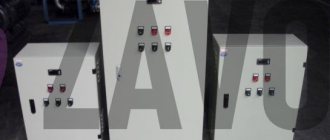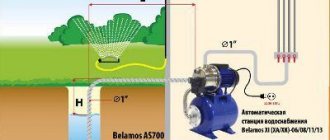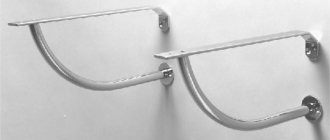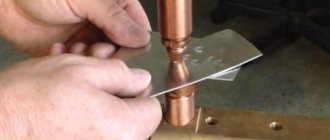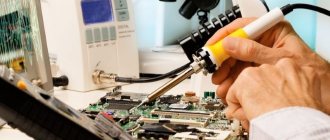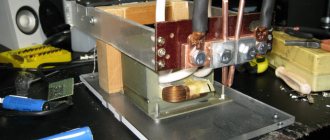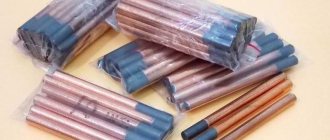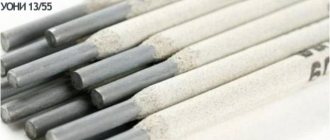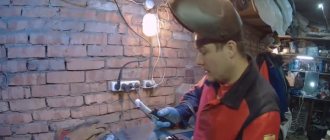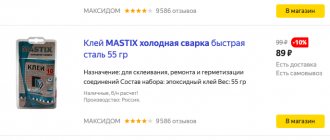Home / Welding technique
Back
Reading time: 4 min
1
4772
First, let's figure out what it is. If, when using electric arc welding, we also turn on short electric pulse signals, then we will get pulsed welding.
In this case, the main thing is not to draw a parallel of this type with spot welding.
Pulse spot welding and pulsed arc welding are completely different methods of welding metal parts.
- Let's analyze the algorithm for collecting pulsed welding Converter
- Control mechanism
- Adapter
Let's analyze the pulse welding collection algorithm
Converter
To begin with, it is necessary to consider the process of assembling a pulse converter. It is accordingly designated as the power element of the welding unit.
The diagram shows the transducer assembly model.
In technical literature and reference books you can find information on the components that are included with the converter.
Control mechanism
In this figure you can see a clear and understandable control diagram, as well as elements of the diagram, which shows the process of starting the electric unit.
Adapter
A descriptive representation of the pulse adapter is shown in the accompanying diagram.
“Soft Launch” is located here.
Micropulse welding
Pulse welding technology was developed in dentures in the form of arc microwelding. Its advantages lie in the feasibility of using this technology when welding such thin-sheet dental metal as titanium. The micropulse welding machine used has proven itself well in dental practice. This device is capable of joining any dental alloys, including titanium. In terms of the quality of the weld, it is not inferior to a laser machine, but at the same time it costs much less. Therefore, even small dental clinic owners can afford it.
The micropulse welding machine has a closed housing that protects against sparks and flashes, and is also equipped with a convenient tip and bright LEDs, which allows you to work with maximum convenience. To work with such a device, no welding skills are required.
Assembled device
Just look at the figure below to have a simple idea of the appearance of this type of welding.
The body is also attached to a frame with airflow, a control adapter (it is an integral part of the body), and a plug for welding current.
The electrical fuse and power adapter must also be located on the housing.
The concept of welding “rigidity”
Electrical circuit of a welding transformer.
“Mode rigidity” is one of the most important technological characteristics of pulse welding. This parameter shows the ratio of the pause duration to the pulse duration.
Mode severity should be understood as the penetrating ability of the arc in special pulse welding machines. By changing the basic parameters of the welding process, the operator can change the shape of the weld pool and its dimensions, control the process of metal crystallization, form a welding seam, adjust the limits of deformation, etc.
It is precisely because of the possibility of changing the rigidity of the mode in special welding equipment that the penetration properties of a pulsed welding arc are the most effective when it is necessary to connect sheet metal products with a thickness of 3 mm or less.
Schematic diagram of a pulse welding machine for spot welding.
Pulse welding has proven itself as a method for creating seams of various spatial positions. Thanks to these and other characteristics, pulse techniques are a priority when making horizontal and vertical seams, ceiling seams, combining joints on various types of pipes, etc.
DC converters are predominantly used as power sources in pulsed welding. Additionally, pulsed units use sources of the TIR and VSVU series.
It was previously noted that the receiver battery helps ensure a uniform load on the phases and does not create too much load on the network. Such a battery delivers short and powerful pulses to the welded joint area. Otherwise, the welding process is performed almost the same as any other technology familiar to all welders.
Practice of use
Devices assembled as stated in the instructions work for a long time. Welding joints are quite strong.
A homemade pulse welder is only suitable for household use, but it is not suitable for professional work. The costly part of assembling such a welder will not leave any owner indifferent.
The voltage required for the operation of such a device should be within 220 V. But sometimes there may be voltage failures, especially if the work is carried out in a country house.
Micropulse welding
To work with dental titanium alloys in dental prosthetics, micro-arc welding devices have been developed that make it possible to connect thin-sheet elements no worse than lasers. Micropulse welding forms a high-quality butt joint that does not require additional surface treatment.
The compact device is very convenient and inexpensive. Purchased by small dental laboratories and large orthopedic centers. A closed body, a convenient needle tip with LED illumination - this device is used by dental technicians who do not have welding experience.
Priorities of a welding machine manufactured in-house
The pulse welder differs from factory models in many characteristics. A serious advantage is low energy consumption.
The energy costs for performing a minor weld using a factory machine will be high. And of course, not all electrical wiring can withstand such power.
Regarding the weight of the homemade device, we can say that it is small. And its dimensions can be several times smaller than the factory ones. It is very difficult to move a factory apparatus without much effort.
To avoid moving it from place to place, you can use special electrical extension cords. But their cost is very high.
Therefore, a homemade welding machine would be a suitable option for use at home. And its weight will not exceed 10 kg.
The production resource of production welding devices has a limitation. And often it may not exceed 50-80%.
Therefore, the totality of all available technical capabilities cannot always be revealed. Based on this, the duration of welding work will be insignificant, within 3 minutes without a break.
A homemade welding machine does not lead to loss of electrical energy because there are no reactive currents. Non-critical power allows you to use the outlet even in the house, without worrying that the network may not be able to withstand it.
The power of such a pulse welder is exactly the same as in household appliances.
The duration of operation of a homemade pulse apparatus can be more than 15-20 minutes. Which exceeds the operating time of the mechanism that was bought in the store. And of course, the light weight (8-10 kilograms) will not cause difficulties in home use.
By assembling a pulse unit on your own, you can minimize the cost of assembled materials.
Advantages and disadvantages
The method is used when installing critical connections; it is convenient when installing pipelines - you can work with an electrode or filler wire in any position. Adjusting the pitch of the impulse points makes this method universal. Pulse welding has advantages and a number of possibilities. Pros:
- Due to a short-term impulse, the drop falls evenly into the metal junction zone. Pulse devices can significantly increase the penetration rate. It becomes possible to join parts for which conventional electric arc welding is not applicable, for example, joining thin sheets of aluminum.
- Excellent quality of the seam - the bead is formed uniformly, with smooth edges, it does not require stripping, additional processing, or forging.
- The risk of burns and lack of penetration is reduced; defects occur in exceptional cases with unstable voltage.
- Metal spattering in the melt bath is eliminated.
- The consumption of electrodes or wire when working semi-automatically is reduced by up to two times.
- Connection possibilities are expanded: pulse welding connects dissimilar metals.
- Precise control of the additive melt moment, stability of operating conditions.
- During startup, the risk of short circuit is eliminated.
Minuses:
- The converter gets too hot - it is necessary to provide a reliable cooling system.
- Cannot be used over large areas.
- Models for domestic use have not been developed; industrial ones are too expensive.
- The TIG mode has low efficiency; it is necessary to regulate the additive supply mode.
Peculiarities
Let us dwell on the advantages of homemade impulse welding machines.
To stabilize the ignition of the welding arc, it is best to resort to working with a transformer, which has a significant degree of inductance.
But at the same time, a decrease in current strength may occur, since alternating current is mainly used, and the efficiency is very low.
Despite this, if the devices operate on direct current, a special choke helps regulate the current itself. Because of this, the recovery process of the arc is reduced.
It goes without saying that direct current is used. But do not forget to monitor the inductance of the inductor. If it exceeds the standard values, the electrode may simply stick to the surface, which must be welded.
If you keep the inductance of the inductor at a low level, and the frequency of the current on the contrary, then you can still achieve arc ignition without delay.
Do-it-yourself pulse-arc microwelding
This is a process of welding metals with a tungsten electrode in an inert gas environment, also called TIG welding (from the English Tungsten Inert Gas). In TIG welding, a pointed tungsten electrode is used in combination with electrical energy to create and maintain a high-temperature plasma stream - a plasma arc. The plasma arc is used as a heat source to melt the work surfaces.
Filler metal can also be added to build up the joint and form strong and reliable weld beads, or weld joints. Pulsed arc welding (TIG) welding machines can use AC or DC power to create a plasma arc.
Sunstone Engineering, based on its extensive experience, has chosen DC welding technology. The Orion series machines use industrial capacitive discharge technology for pulsed arc welding. AC voltage in networks can vary within a day in the range of 20%.
Capacitive welding machines have an advantage over AC technology - they store exactly the required amount of energy before the welding process. This means Orion can form repeatable seams regardless of AC surges.
The Orion series pulse arc welding machines are micro-TIG welding machines that allow extremely good control over all welding parameters. This control allows you to work with any work surface - from welding thin sheets to forming roller seams on medium-sized steel surfaces.
Why is shielding gas required for pulsed arc welding?
During the pulsed arc welding process, high temperature plasma rapidly melts the metal in the weld pool at the welding application site. If air from the environment comes into contact with molten metal, oxygen from the air quickly reacts with the hot metal. The result is a metal oxide that is brittle, porous, and causes the weld joint to appear burnt.
If we use an inert shielding gas such as pure Argon (high frequency argon, 99.9%, grade Argon 4.6 and above), we can prevent these effects. Argon is used to displace oxygen from the welding area. For an active electric arc, the shielding gas acts as a barrier, preventing the penetration of oxygen into the welding zone.
After the welded joint has cooled, the shielding gas is turned off and its supply to the welding zone is stopped.
What is resistance welding (also called resistance welding, fusion welding, and resistance spot welding)?
Resistance welding (resistance welding, fusion welding) is very different from the TIG welding process. In resistance welding, a high-intensity electric current passes through two work parts, connecting them to each other. At the point of contact between two materials, there is strong resistance to the flow of electrically charged particles. And, when electric current flows through this contact point, resistive heating occurs.
With a large enough current flowing through the work parts, the temperature (especially at the interface between the two parts) can become high enough to melt the metal at that point. The terms "resistance welding", "resistance welding" and "spot welding" clearly describe this process. By limiting the amount of power and electrical current applied to the weld, a temporary or weak weld can be formed, called a tack weld.
Tack welding is quite often used in different situations to solve different problems. It makes it possible to temporarily join parts together before permanently welding them together. This also helps eliminate the need for complex fastening or fixing of parts before permanent welding or soldering. Regardless of the application, permanent resistance welding is also very useful.
With the Orion series, you can weld clamps and wires, make temporary connections, tack bolts, cover or cover parts, weld hinge bolts, supports and much more. Since Orion machines are based on industrial capacitive resistance welding technology, they can be used to solve all problems - from one-time welding of non-standard parts to production flow welding.

